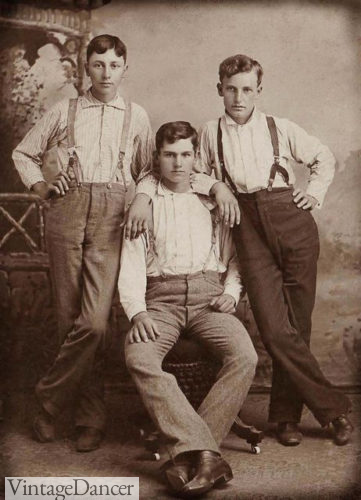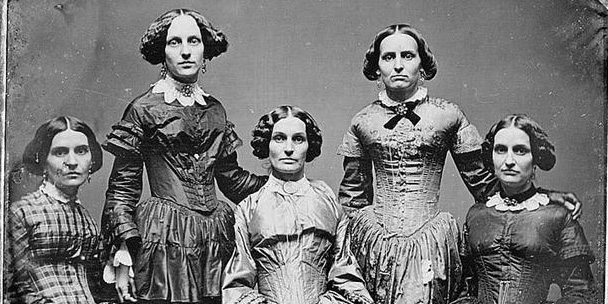It was at this time in the 19th century that womens clothes in the upper echelons of society came to be more sexualized. See more ideas about regency fashion regency dress historical clothing.

Working Class Costumes Of Scheveningen Netherlands 19th Century Fisherman Woman Stock Illustration Download Image Now Istock
Once focused closely on institutional dynamics in the workplace and electoral politics labor history has expanded and refined its approach to.

. Womens fashion during the Victorian period was largely dominated by full skirts which gradually moved to the back of the silhouette. This was the top of the working class pyramid. When history emerged as a scholarly discipline in British universities at the end of the 19th century it rarely took.
A North London street 1950s. 1830s fashion was dramatic and overwhelming marked by huge sleeves and hats reflecting the Romantic movement. Most servants were female.
In eighteenth-and early nineteenth-century Britain the red woolen hooded cloak was commonly worn by rural women. The common utilitarian dress for laboring men before the twentieth century was made up of breeches or trousers jackets and waistcoats of hard-wearing materials such as moleskin fustian or corduroy. Though a new style called the sack coat a thigh-length loosely.
At the eve of Industrial change throughout Europe London stood above the other powers. Short-fronted tailcoats and fitted waistcoats were worn over plain white linen shirts. Male servants were much more expensive because men were paid much higher wages.
Men wore matching coats waistcoats and trousers with hairstyles characterised by large mutton-chop side-burns and moustaches after the style set by Prince AlbertShirts had high upstanding collars and were tied at the neck with large bow-tiesHigh fastening and tight fitting frock coats were also very fashionable. This flap was universally held in place by two or three buttons at the top. Only the very poor or the very rich would dare stray from the dictates of the time.
Emma Griffin charts the postwar emergence of working-class history as a scholarly discipline and argues that thanks to the torch-bearers the rationale for it has ebbed away. The railways generated employment for porters and cab-drivers. During the 19th century women of Western Europe and North America always wore head coverings outdoors or in public.
Women used boots instead of shoes. Pattens and then clogs were valuable assets for workingmen and -women on dirt roads and later in factories and mills. Extravagant dandies led the fashion world.
While clothing was determined by the days activities the basic underclothes or foundational layer for all outfits a chemise drawers stockings corset and petticoats remained fairly consistent. See more ideas about 18th century 18 century art 18th century clothing. In the late 19th century about 80 of the population of the population was working class.
In the 19 th-century all women wore several layers of clothing though the clothing got more complicated depending on their socioeconomic status. However towards the end of the period the less restrictive Aesthetic style began to emerge. After 1836 the exuberance that had defined fashion since the 1820s collapsed into a drooping sentimentality.
No belts were worn. The single or double breasted frock coat fitted quite closely to the torso and had a waist seam. For day wear frock coats and straight trousers a short waistcoat and a shirt with a high stiff collar were worn.
Upper class men wore silk or wool broadcloth vests. In class-conscious 19th-century society fashion was key as a way of demonstrating social position and wealth. Even laborers wore vests at work as appearing in only a shirt was considered inappropriate.
Throughout the century service was a major employer of women. Mar 25 2018 - Explore Amy Lieberts board Early 19th century work garments on Pinterest. Womens clothing accentuated and exaggerated the hips breasts and derriere not only to make the wearer seem more attractive but to separate these wealthy ladies from the world of work.
Pam Inder shares the stories of those who dressed the 19th. In some situations working women were the. But how much did it cost to remain à la mode and who were the people who made these clothes.
Most working class women in Victorian England had no choice but to work in order to help support their families. In order to be considered middle class you had to have at least one servant. By the turn of the 19th century breeches pantaloons and trousers worn by all men were sewn with a flap in front called a fall front.
Women and work in the 19th century. Cutaway Tail Coat 1805-1810. 19th Century Urban Working Class.
The London omnibuses needed 16000 drivers and conductors by 1861. Women kept their hair covered due to modesty tradition religious beliefs personal decoration and protection from the elements. In 1800 working-class people wore linen underwear men wore woollen outer clothing and women wore cotton linen and woollen dresses.
Ad Browse Discover Thousands of Arts Photography Book Titles for Less. 1830-1839 19th century decade overview. Working men wore vests of heavy cotton or denim.
Women and work in the 19th century. Waistcoats were always worn over a white shirt. By 1850 the cotton linen and woollen trades were fully mechanised in England.
A skilled London coach-maker could earn up to five guineas 5 five shillings a week considerably more than most middle class clerks. Early 20th century American labor and working-class history is a subfield of American social history that focuses attention on the complex lives of working people in a rapidly changing global political and economic system. Feb 18 2022 - Explore Charles Winchesters board Working Class Dress of the Eighteenth Century on Pinterest.
Today the working class is not looked on by society as something to aspire to be but the whole class did not exist largely before the 19th century and was instead a peasant class existed that performed labor for lords of the land. Tight-fitting pantaloons replaced eighteenth century knee breeches Hessian boots replaced buckled shoes and intricately tied white linen neck cloths became the mark of the true man of fashion. They worked either in factories or in domestic service for richer households or in family businesses.
The skirts were straight and finished to the mid thigh or below. The fashion of the 19th century is renowned for its corsets bonnets top hats bustles and petticoats.

A Working Class Family Circa 1880 Victorian Life Class Outfit Victorian Clothing

Working Class Fashion Late 19th Century Ireland R Historicalcostuming

Working Class Jacket 18th Century Fashion 18th Century Costume 18th Century Clothing

1910s Men S Working Class Clothing

Stitching The Fashions Of The 19th Century Who Dressed The 19th Century Elite Historyextra

Working Class Victorian Life Witness2fashion


0 comments
Post a Comment